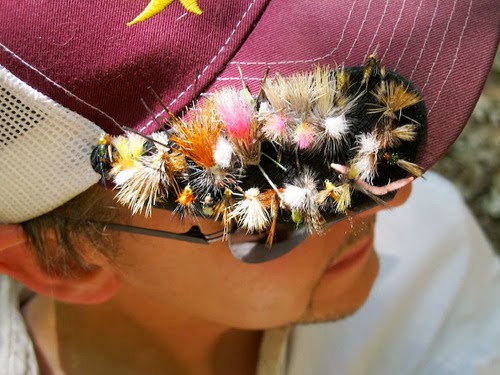How to use this blog? Use the blog search engine and type in key words such as Float Trip, Walk-Wade, Float Tube, Lessons, DIY, Pesos, Fy Rods, Lodging, Food, Wine, Flies, Best Months, etc. The search engine is located on the right side, just below the weather. FYI, there are over 100 post about fishing Patagonia...the information you are looking for, is probably on this blog. Thanks.
We all know the fly fishing industry offers many opportunities to buy gadgets. There is nothing wrong with this, but what about making your own gadget? In this post, I will share a few self-made gadgets that you can easily make on your own. Specifically, I am going to focus on devices designed to hold your flies, outside of your fly box. But, before I share my knowledge and self-made devices, allow me to show you what the industry offers.
Industry Fly Patch Hat
 |
| Hat is sold with built in patch, or a device that can clip on. |
Industry Attachable Fly Patch
 |
| Modern Foam |
 |
| Classic Wool |
Industry Automobile Fly Patch
 |
| A piece of foam that clips or sticks. |
Self-Made Devices
 |
| I bought a package of self adhesive velcro strips at a local store. These strips come in a variety of sizes. Before adding the velcro strips, I added a thin layer of glue to the bill. Why? The velcro strips are designed to adhere to smooth surface, not fabric on the bill of a baseball cap. Figure out a system that allows the velcro strips to dry and bond to the fabricate. The ultimate goal is to avoid to poor surface contact (gaps). I used a set of heavy books to press the velcro strips overnight. You'll find this to be far less expensive than the above industry option. NOTE: If you don't pinch down the barbs on your hooks, you'll have a hell of a time getting them out of the velcro! |
 |
Do you drink wine? Then you have already procured the key component of this hand made fly keeper.
Step #1: Finish drinking your glass of wine and enjoy good company. Step #2: Drill a hole in the center of the cork. Be sure not to drill into the surface you are working on; especially your wife's kitchen table. FYI, synthetic corks are easier to work with. Be sure to make the hole no bigger than the diameter of the line you intend to use. Your choice of line is entirely up to you. Step #3: Feed the line through the hole. Make sure you use enough line to make two knots seen in the photo. I used Albright stopper knots for this set-up, but on the top knot, you could forgo the snap swivel and easily use a loop knot. Step #4: On the tag ends, to prevent fraying, put a match to the line. By introducing heat to the tag ends, the material will permanently bond. Step #5: Attach to your lanyard, fishing vest, sling bag, etc. Compared to the industry options, this is extremely inexpensive and effective. They make great gifts for beginner anglers and friends. If the cork wears out, buy another bottle of wine and repeat the steps :) PS. If you buy the wine, I'll teach you for FREE! |
 |
| Easily clips to my lanyard. Speaking of my lanyard, can you see my surgical tweezers? Tweezers have proven to be a good tool. Also, rather than buy a retractable zinger for my forceps, I use a fixed length of line = I have never had a problem. For safety, emergencies, and general communication, I use a coaching whistle. I believe every angler should have a coaching whistle, especially DIY anglers, who like to explore. |
|
|
Similar to my hat idea, buy velcro strips and attach to your car visor. I did not have to use extra glue to bond the strips to this surface. Compared to the industry options, this is very inexpensive and does not effect the value of your vehicle.
|
Final Word
You could spend a small fortune on fishing gadgets that you don't need, or you could easily make them yourself. So, the take away message is: think about your options and dare to be creative! In the end, the fish don't care what gadget you prefer, only the people watching you. Plus, you just might save enough money to buy an extra bottle of wine.
Thanks for reading and I hope you enjoyed this post.
Gone Fishing,
Mark
PS. Here's a quick blurb on fly line straightener's/cleaners.
 |
| The outside is leather. The inside is one part rubber, and the other part, is a synthetic material for drying/cleaning. |
 |
| I use a piece of old bike tire inner tube. I can get a bike tire inner tube for free, from my local bike shop. How to use? Add water or saliva to the rubber patch; place leader in the middle of the rubber patch, and then fold it in half; then run leader through, as desired. While on the river, I have never had the need to have a fly line cleaner, or a device to dry my flies. If I need to clean my line, this process is done at home, with warm-soapy water. |










